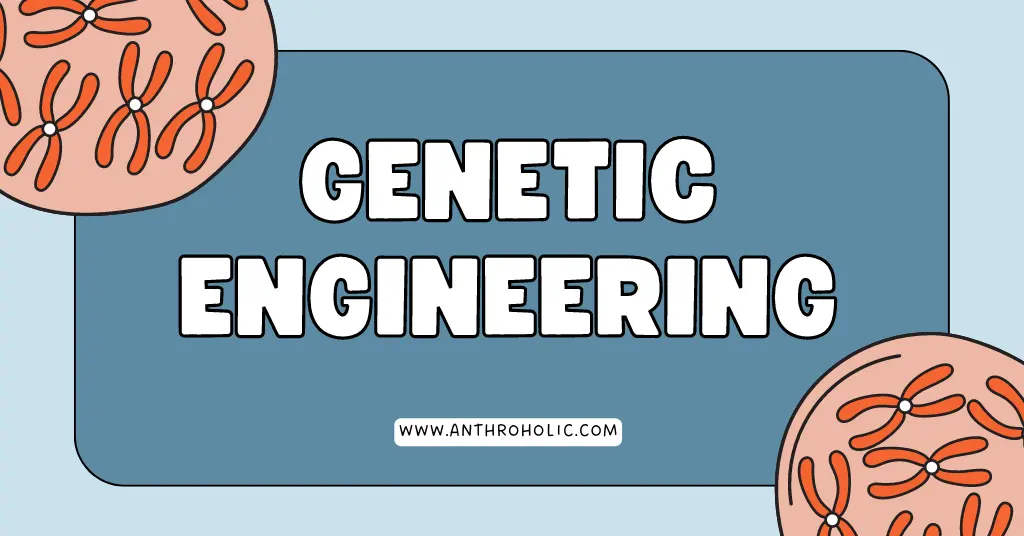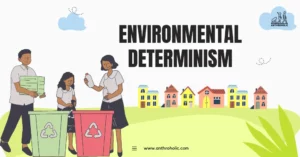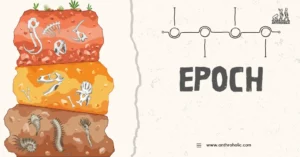AI Answer Evaluation Platform Live Now. Try Free Answer Evaluation Now
Genetic Engineering
Genetic engineering, also known as genetic modification or manipulation, refers to the deliberate modification of an organism’s genetic material using biotechnological techniques. It is a relatively young field, having first come into prominence in the latter half of the 20th century.

The inception of genetic engineering was largely marked by the discovery of the structure of DNA by James Watson and Francis Crick in 1953, a breakthrough that revolutionized our understanding of life [1]. In the 1970s, techniques were developed that allowed scientists to cut and paste DNA segments, effectively creating the first genetically modified organisms.
The advent of Recombinant DNA technology provided scientists with a potent tool, allowing them to precisely manipulate genetic material [2]. This led to an explosion of applications, from genetically modified crops that could resist pests and diseases, to medical breakthroughs such as insulin produced by genetically modified bacteria. In more recent years, a new technology known as CRISPR-Cas9 has revolutionized the field, making genetic engineering faster, cheaper, and more accurate than ever before.,
Early Genetic Experiments and Controversies
The early experiments in the realm of genetics can be traced back to the mid-19th century, with Gregor Mendel’s groundbreaking work on inheritance in pea plants. Mendel’s postulates, which later became known as Mendel’s laws, set the foundation for the understanding of genetic inheritance. However, it wasn’t until the 20th century that scientists began to understand the molecular basis of genetics. The identification of DNA as the carrier of genetic information by Oswald Avery in 1944 marked a significant step in this direction [3].
Early genetic experiments involving modification of the genome began in the 1970s with the advent of recombinant DNA technology [2]. These experiments, however, faced significant public and scientific controversy due to ethical and safety concerns, leading to the Asilomar Conference in 1975, where guidelines for biotechnology research were established [4].
Development and Evolution of Genetic Engineering
With the advent of recombinant DNA technology, the 1980s and 1990s saw the development of the first genetically modified organisms, including the Flavr Savr tomato, which was engineered to delay ripening [5]. The commercialization of genetically modified organisms (GMOs) opened a new chapter in the history of genetic engineering, as well as a new set of controversies and ethical dilemmas.
In the early 21st century, the completion of the Human Genome Project provided an exhaustive map of the human genome, expanding the possibilities for genetic engineering.
More recently, the advent of the CRISPR-Cas9 gene-editing system has revolutionized the field of genetic engineering, allowing for precise, efficient, and relatively cheap genetic modifications. However, the ease and accessibility of CRISPR-Cas9 technology have also raised new ethical issues and controversies, including the unregulated use of gene-editing in human embryos, such as in the case of genetically edited babies in China.
Cultural and Social Implications of Genetic Engineering
Genetic engineering does not exist in a vacuum, but rather within diverse cultural and social contexts that shape how these technologies are understood and used. Its implications are profound and varied, touching upon aspects of individual identity, societal structures, and cultural norms.
In terms of identity, genetic engineering has the potential to redefine our understandings of kinship and ethnicity. For example, genetic technologies have been used in attempts to define or claim indigenous identities, raising questions about the nature of ethnicity and the role of genetics in its constitution.
Moreover, genetically modified organisms (GMOs) have sparked debates across different cultures, with some societies embracing these technologies and others rejecting them based on cultural beliefs and practices surrounding food.
The potential for genetic enhancements also stirs ethical debates about societal structures. If only certain segments of the population can afford or access genetic enhancements, it could potentially exacerbate social inequalities.
Anthropology’s Role in Understanding Genetic Engineering
Anthropology, with its holistic approach to understanding human societies, is uniquely positioned to explore the social and cultural implications of genetic engineering. Anthropologists can illuminate how different cultures understand and interact with genetic engineering, elucidating the cultural assumptions and values that shape these interactions.
Moreover, anthropology can contribute to bioethics by providing nuanced, contextual insights into ethical debates surrounding genetic engineering. For example, anthropological research can elucidate how various cultures understand concepts like “nature” and “natural”, which are often central to debates about the ethics of genetic manipulation [6].
Ethics in Genetic Engineering: Core Issues
Consent and Autonomy
One of the fundamental ethical issues in genetic engineering is the right to consent and autonomy. The potential for genetic modification of human embryos, for instance, raises profound questions about consent. An embryo cannot provide consent for genetic alterations, yet these modifications could have lifelong impacts and be passed onto future generations.
Autonomy also comes into question when considering genetically modified organisms (GMOs). Consumers must be able to make informed decisions about whether they want to consume GMOs, yet without clear labeling and public education, this autonomy may be compromised.
Equity and Access
Access to genetic engineering technologies can deepen existing societal inequities. If these technologies are expensive and only available to a select few, they could exacerbate socioeconomic disparities and create a genetic underclass. The potential for genetic enhancements could also create new forms of inequality, whereby those who can afford to enhance their genetic makeup or that of their offspring may gain unfair advantages.
Genetic Privacy
The rapid advancement of genetic technologies and the increasingly common practice of genetic testing and sequencing has brought issues of genetic privacy to the forefront. The fear is that genetic information could be used in discriminatory ways, such as in employment or insurance underwriting. Additionally, there are concerns about who owns and has access to genetic information, which can reveal deeply personal information about an individual.
Biological Determinism and Genetic Essentialism
Biological determinism refers to the idea that an individual’s genetics exclusively determines their physical and behavioral characteristics, downplaying the role of environmental influences. This concept is closely related to genetic essentialism, the notion that there are essential, unchanging properties within genes that determine characteristics or behaviors.
The concern is that the advancements in genetic engineering may inadvertently promote these deterministic views, leading to an oversimplified understanding of human nature and possibly to stigmatization or discrimination. It also raises ethical questions about whether certain traits should be selected or deselected in the process of genetic modification.
Playing God Argument: Designing Future Generations
One of the most frequently raised ethical objections to genetic engineering is the “playing God” argument. This argument suggests that humans are overstepping their boundaries by manipulating genetic material, a process that could lead to designing future generations. Critics worry that such control over human nature could lead to eugenics or ‘designer babies,’ where parents could potentially select for superficial traits, such as physical appearance, rather than health-related ones.
Genetically Modified Organisms and Ecosystems
Genetic modification isn’t only about humans or animals; a significant part of it involves genetically modified organisms (GMOs) like crops. While they hold potential for improving crop yield and resistance to pests, GMOs pose several ethical and environmental concerns.
There’s fear of potential risks to biodiversity and ecosystems from the introduction of GMOs. They could out-compete wild varieties or breed with them, altering local flora and fauna in unpredictable ways.
Moreover, there’s also a concern about the long-term health effects of consuming GMOs, and the dominance of a few corporations in the field, raising questions about food security and sovereignty.
Cross-Cultural Perspectives on Genetic Engineering
Western Ethical Perspectives
Western ethical perspectives on genetic engineering are often influenced by values such as autonomy, justice, beneficence, and non-maleficence. These perspectives frequently focus on ensuring informed consent, protecting privacy, and promoting fairness in access to genetic technologies.
For example, in the context of GMOs, Western debates often revolve around issues of consumer choice, labeling, and environmental impact. In the realm of human genetic engineering, the emphasis is often on preventing genetic discrimination and ensuring that such technologies are used for health-related purposes and not for non-medical enhancements.
Eastern Ethical Perspectives
Eastern ethical perspectives, particularly those influenced by Confucianism, Buddhism, and Hinduism, may emphasize values such as harmony, balance, and interconnectedness. These values may lead to a more holistic view of genetic engineering, where the impacts on society and the natural world are as important as individual benefits.
For instance, in Japan, which combines Western biomedical science with Eastern philosophies, there has been resistance to genetically modified food due to concerns about disrupting the natural order.
Indigenous Peoples’ Perspectives
Indigenous perspectives on genetic engineering often focus on respect for all forms of life and the interconnections between them. Many indigenous cultures hold beliefs about the sanctity of life and the intrinsic value of biodiversity, leading to skepticism or opposition to genetic modification practices that disrupt these connections.
For example, many indigenous communities in New Zealand have voiced concerns about the potential impact of GMOs on their traditional lands and food sources.
Case Studies
The CRISPR-Cas9 Controversy: Chinese Twins’ Genetic Alteration
The case of the first genetically edited babies in China, born in 2018, is one of the most controversial instances of genetic engineering to date. He Jiankui, a Chinese scientist, claimed to have used the gene-editing tool CRISPR-Cas9 to alter the CCR5 gene in two embryos before implantation, intending to make the resulting twins resistant to HIV. This act received international condemnation for its ethical violations, including a lack of transparency, informed consent, and violating a widely held moratorium on germline gene editing in humans.
Genetically Modified Crops: A Solution for Hunger or an Ethical Dilemma?
Genetically modified (GM) crops are heralded by some as a solution to world hunger, enhancing agricultural productivity, and improving nutritional content. Golden Rice, fortified with Vitamin A, exemplifies this promise.
However, GM crops also bring ethical challenges. They’ve been associated with increased use of herbicides, potential harm to non-target organisms, and threats to biodiversity. They also raise issues of food sovereignty, with the majority of GM seeds controlled by a few multinational corporations.
The Human Genome Project: Unraveling the Blueprint of Life
The Human Genome Project (HGP), an international effort to sequence and map all the genes in the human genome, was completed in 2003. It has revolutionized our understanding of human genetics, offering insights into disease processes and the development of precision medicine.
However, the HGP also raised ethical issues, most notably surrounding genetic privacy and potential discrimination based on genetic information. It prompted the development of legislation such as the Genetic Information Nondiscrimination Act in the U.S. to protect against such discrimination.
Guidelines and Policies Around the World
The United Nations and Genetic Engineering
The United Nations has numerous entities involved in establishing guidelines and principles surrounding genetic engineering. The Convention on Biological Diversity (CBD), for example, seeks to promote biodiversity conservation and sustainable use, including responsible handling of genetically modified organisms.
The Cartagena Protocol on Biosafety, a supplementary agreement to the CBD, specifically focuses on transboundary movements of living modified organisms, with the aim of protecting biological diversity and human health.
Regulation in the United States: FDA and NIH Guidelines
In the United States, the Food and Drug Administration (FDA) regulates genetically modified organisms under the Coordinated Framework for the Regulation of Biotechnology. Genetically engineered animals, including those intended for food, are evaluated under a rigorous process before they can be marketed.
The National Institutes of Health (NIH) also maintain guidelines for recombinant DNA research, which includes genetic engineering.
European Union Regulations: Precautionary Principle
The European Union (EU) follows a precautionary principle in regulating genetically modified organisms, focusing on risk assessment and management. The EU’s stance is more conservative compared to the U.S., often leading to stricter regulations and bans on certain GMO products.
Regulations in Developing Countries
Regulations in developing countries vary widely. Some, like Brazil and Argentina, have embraced GM crops to boost agricultural productivity. Others, particularly in Africa, have been more cautious due to a lack of regulatory frameworks, concerns about dependence on foreign biotech, and potential impacts on biodiversity.
Anthropology’s Contribution to Policy Discussions
Anthropology, with its emphasis on holistic and culturally relative perspectives, is uniquely positioned to contribute to policy discussions on genetic engineering. Its strength lies in its ability to elucidate how different communities perceive, interact with, and are affected by genetic engineering technologies.
- Understanding Cultural Contexts: Anthropologists excel at illuminating the cultural contexts within which scientific developments take place. They elucidate the myriad ways in which societies perceive genetic engineering and how these perceptions influence individuals’ acceptance or rejection of these technologies. This cultural understanding can help policymakers frame genetic engineering developments in ways that resonate with community values, traditions, and beliefs.
- Identifying Ethical Implications: Anthropologists often engage in ethical discussions surrounding new technologies. When it comes to genetic engineering, they can highlight concerns about consent, privacy, fairness, and potential impacts on cultural diversity. By so doing, they can help ensure that policies do not just focus on science but also address these essential ethical dimensions.
- Influencing Public Engagement: Anthropologists can play a critical role in facilitating public discussions about genetic engineering. By using their insights into local languages, metaphors, and narratives, they can help demystify complex genetic concepts, promote informed dialogue, and facilitate public participation in decision-making processes.
- Advocacy and Social Justice: Anthropologists are often advocates for marginalized or vulnerable populations. In the context of genetic engineering, they can help ensure that access to benefits is equitably distributed, and that potential harms do not disproportionately fall on the least advantaged members of society.
Future Research Directions in Anthropology and Genetic Engineering
As genetic engineering continues to advance, there are several key areas where anthropological research can contribute new insights and perspectives. These future research directions include:
- Understanding the Anthropology of Genetics: Exploring the interplay between genetics and culture, including how genetic engineering is influencing our understanding of identity, health, kinship, and notions of personhood. This could include research on the social and cultural implications of personalized genomics, gene editing for human enhancement, or the use of genetic testing in determining ancestry or tribal affiliation.
- Genetic Engineering and Inequality: Investigating how genetic engineering might contribute to new forms of inequality. This could include research on access to and control over genetic technologies, how benefits and risks are distributed, or the role of genetic engineering in reinforcing or challenging social hierarchies and structures of power.
- Public Engagement and Policy Development: Conducting research on how genetic engineering is understood and debated within the public sphere, and how these public conversations can inform policy development. This could involve exploring how genetic engineering is represented in the media, how communities are engaging in citizen science initiatives, or how public perceptions of genetic engineering influence political and regulatory responses.
FAQs about Ethics in Genetic Engineering
References
[1] Watson, J. D., & Crick, F. H. (1953). Molecular structure of nucleic acids: a structure for deoxyribose nucleic acid. Nature, 171(4356), 737-738.
[2] Cohen, S. N., Chang, A. C., Boyer, H. W., & Helling, R. B. (1973). Construction of biologically functional bacterial plasmids in vitro. Proceedings of the National Academy of Sciences, 70(11), 3240-3244. https://www.ncbi.nlm.nih.gov/pmc/articles/PMC427208/
[3] Avery, O. T., MacLeod, C. M., & McCarty, M. (1944). Studies on the Chemical Nature of the Substance Inducing Transformation of Pneumococcal Types: Induction of Transformation by a Desoxyribonucleic Acid Fraction Isolated from Pneumococcus Type III. The Journal of Experimental Medicine, 79(2), 137–158. https://pubmed.ncbi.nlm.nih.gov/19871359/
[4] Berg, P., Baltimore, D., Brenner, S., Roblin, R. O., & Singer, M. F. (1975). Asilomar conference on recombinant DNA molecules. Science, 188(4192), 991–994.
[5] Flavell, R. B. (1994). Inactivation of gene expression in plants as a consequence of specific sequence duplication. Proceedings of the National Academy of Sciences, 91(9), 3490–3496. https://doi.org/10.1073/pnas.91.9.3490
[6] Franklin, S., & Roberts, C. (2006). Born and made: An ethnography of preimplantation genetic diagnosis. Princeton University Press.




